Cross-Cultural Negotiation Styles in Finance
VerifiedAdded on 2020/02/18
|69
|22097
|39
Thesis and Dissertation
AI Summary
This thesis examines the cross-cultural differences in negotiation styles between financial services firms in China and the UK. It highlights how cultural factors influence negotiation approaches, emphasizing the need for understanding these differences to enhance international business interactions. The study employs a descriptive research design, utilizing secondary data to analyze negotiation styles and their implications for business practices. Key findings reveal significant contrasts in negotiation strategies, with recommendations for practitioners to navigate these cultural nuances effectively.
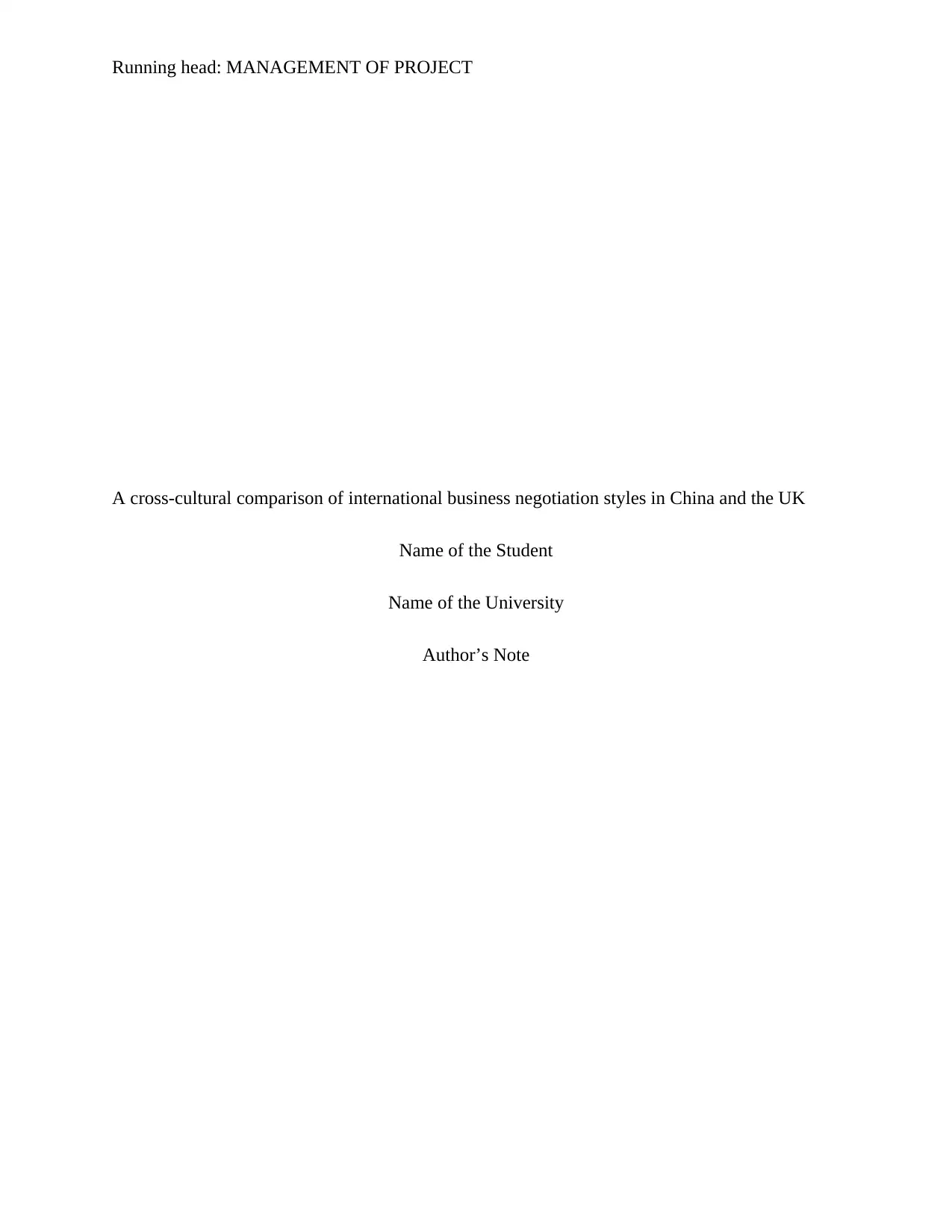
Running head: MANAGEMENT OF PROJECT
A cross-cultural comparison of international business negotiation styles in China and the UK
Name of the Student
Name of the University
Author’s Note
A cross-cultural comparison of international business negotiation styles in China and the UK
Name of the Student
Name of the University
Author’s Note
Paraphrase This Document
Need a fresh take? Get an instant paraphrase of this document with our AI Paraphraser
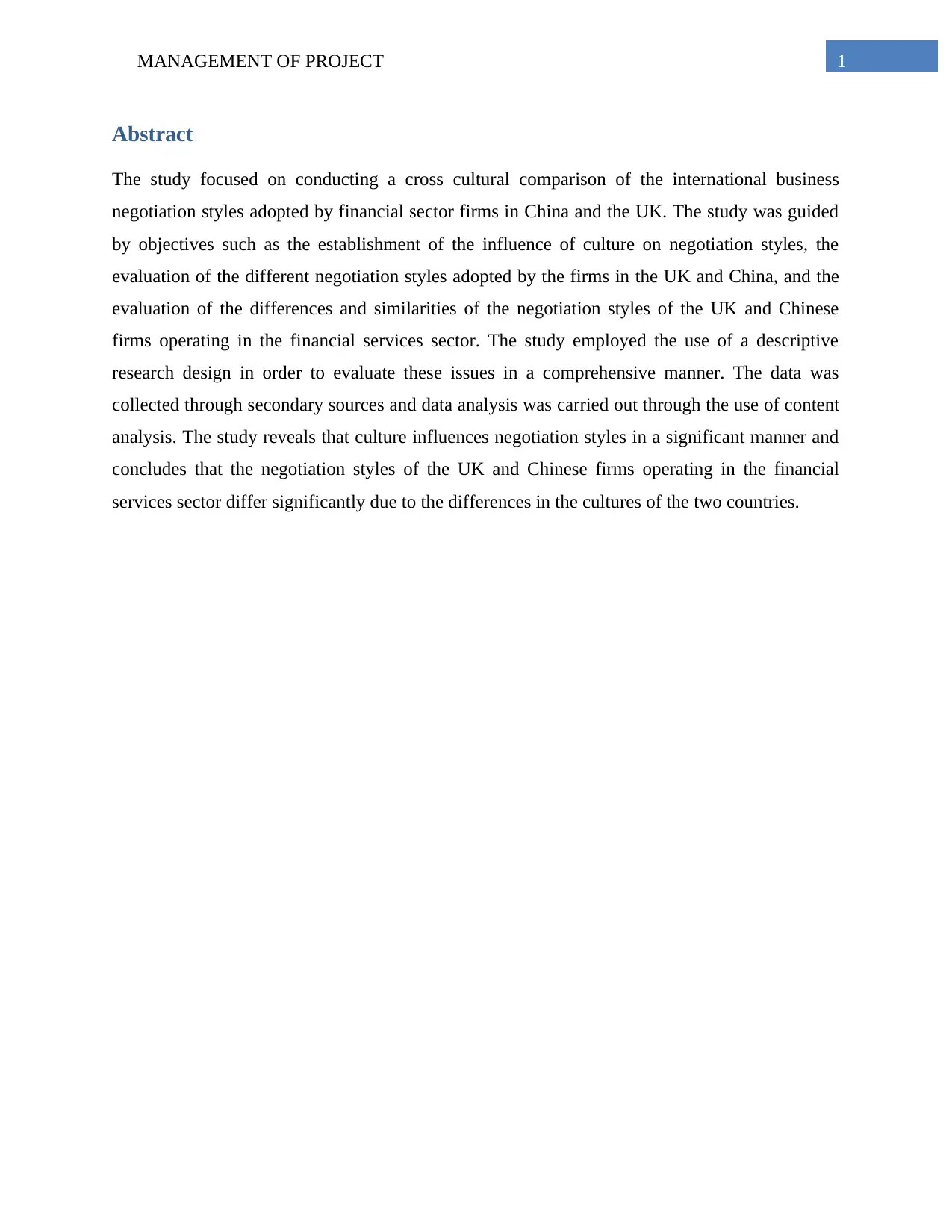
1MANAGEMENT OF PROJECT
Abstract
The study focused on conducting a cross cultural comparison of the international business
negotiation styles adopted by financial sector firms in China and the UK. The study was guided
by objectives such as the establishment of the influence of culture on negotiation styles, the
evaluation of the different negotiation styles adopted by the firms in the UK and China, and the
evaluation of the differences and similarities of the negotiation styles of the UK and Chinese
firms operating in the financial services sector. The study employed the use of a descriptive
research design in order to evaluate these issues in a comprehensive manner. The data was
collected through secondary sources and data analysis was carried out through the use of content
analysis. The study reveals that culture influences negotiation styles in a significant manner and
concludes that the negotiation styles of the UK and Chinese firms operating in the financial
services sector differ significantly due to the differences in the cultures of the two countries.
Abstract
The study focused on conducting a cross cultural comparison of the international business
negotiation styles adopted by financial sector firms in China and the UK. The study was guided
by objectives such as the establishment of the influence of culture on negotiation styles, the
evaluation of the different negotiation styles adopted by the firms in the UK and China, and the
evaluation of the differences and similarities of the negotiation styles of the UK and Chinese
firms operating in the financial services sector. The study employed the use of a descriptive
research design in order to evaluate these issues in a comprehensive manner. The data was
collected through secondary sources and data analysis was carried out through the use of content
analysis. The study reveals that culture influences negotiation styles in a significant manner and
concludes that the negotiation styles of the UK and Chinese firms operating in the financial
services sector differ significantly due to the differences in the cultures of the two countries.
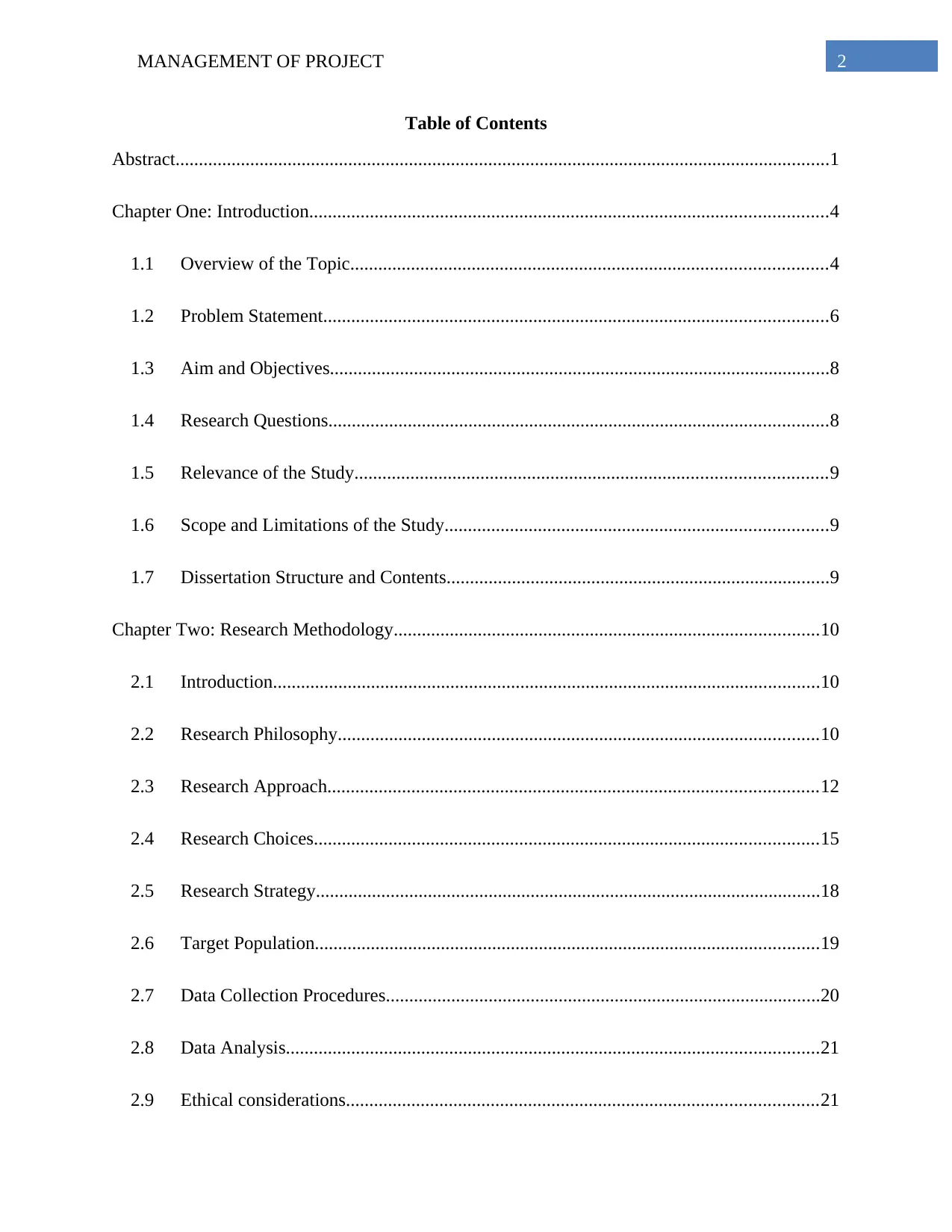
2MANAGEMENT OF PROJECT
Table of Contents
Abstract............................................................................................................................................1
Chapter One: Introduction...............................................................................................................4
1.1 Overview of the Topic......................................................................................................4
1.2 Problem Statement............................................................................................................6
1.3 Aim and Objectives...........................................................................................................8
1.4 Research Questions...........................................................................................................8
1.5 Relevance of the Study.....................................................................................................9
1.6 Scope and Limitations of the Study..................................................................................9
1.7 Dissertation Structure and Contents..................................................................................9
Chapter Two: Research Methodology...........................................................................................10
2.1 Introduction.....................................................................................................................10
2.2 Research Philosophy.......................................................................................................10
2.3 Research Approach.........................................................................................................12
2.4 Research Choices............................................................................................................15
2.5 Research Strategy............................................................................................................18
2.6 Target Population............................................................................................................19
2.7 Data Collection Procedures.............................................................................................20
2.8 Data Analysis..................................................................................................................21
2.9 Ethical considerations.....................................................................................................21
Table of Contents
Abstract............................................................................................................................................1
Chapter One: Introduction...............................................................................................................4
1.1 Overview of the Topic......................................................................................................4
1.2 Problem Statement............................................................................................................6
1.3 Aim and Objectives...........................................................................................................8
1.4 Research Questions...........................................................................................................8
1.5 Relevance of the Study.....................................................................................................9
1.6 Scope and Limitations of the Study..................................................................................9
1.7 Dissertation Structure and Contents..................................................................................9
Chapter Two: Research Methodology...........................................................................................10
2.1 Introduction.....................................................................................................................10
2.2 Research Philosophy.......................................................................................................10
2.3 Research Approach.........................................................................................................12
2.4 Research Choices............................................................................................................15
2.5 Research Strategy............................................................................................................18
2.6 Target Population............................................................................................................19
2.7 Data Collection Procedures.............................................................................................20
2.8 Data Analysis..................................................................................................................21
2.9 Ethical considerations.....................................................................................................21
⊘ This is a preview!⊘
Do you want full access?
Subscribe today to unlock all pages.

Trusted by 1+ million students worldwide
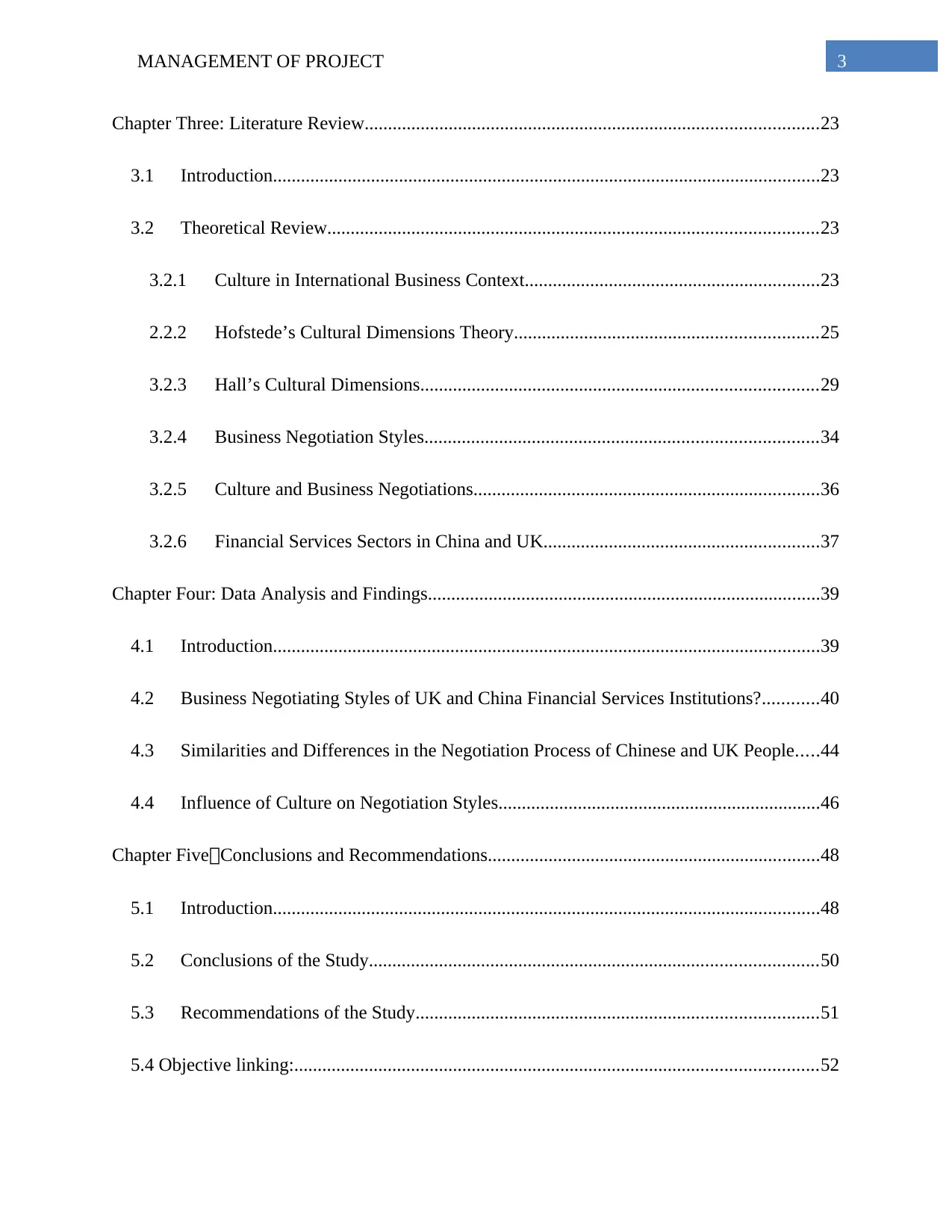
3MANAGEMENT OF PROJECT
Chapter Three: Literature Review.................................................................................................23
3.1 Introduction.....................................................................................................................23
3.2 Theoretical Review.........................................................................................................23
3.2.1 Culture in International Business Context...............................................................23
2.2.2 Hofstede’s Cultural Dimensions Theory.................................................................25
3.2.3 Hall’s Cultural Dimensions.....................................................................................29
3.2.4 Business Negotiation Styles....................................................................................34
3.2.5 Culture and Business Negotiations..........................................................................36
3.2.6 Financial Services Sectors in China and UK...........................................................37
Chapter Four: Data Analysis and Findings....................................................................................39
4.1 Introduction.....................................................................................................................39
4.2 Business Negotiating Styles of UK and China Financial Services Institutions?............40
4.3 Similarities and Differences in the Negotiation Process of Chinese and UK People.....44
4.4 Influence of Culture on Negotiation Styles.....................................................................46
Chapter Five:Conclusions and Recommendations.......................................................................48
5.1 Introduction.....................................................................................................................48
5.2 Conclusions of the Study................................................................................................50
5.3 Recommendations of the Study......................................................................................51
5.4 Objective linking:................................................................................................................52
Chapter Three: Literature Review.................................................................................................23
3.1 Introduction.....................................................................................................................23
3.2 Theoretical Review.........................................................................................................23
3.2.1 Culture in International Business Context...............................................................23
2.2.2 Hofstede’s Cultural Dimensions Theory.................................................................25
3.2.3 Hall’s Cultural Dimensions.....................................................................................29
3.2.4 Business Negotiation Styles....................................................................................34
3.2.5 Culture and Business Negotiations..........................................................................36
3.2.6 Financial Services Sectors in China and UK...........................................................37
Chapter Four: Data Analysis and Findings....................................................................................39
4.1 Introduction.....................................................................................................................39
4.2 Business Negotiating Styles of UK and China Financial Services Institutions?............40
4.3 Similarities and Differences in the Negotiation Process of Chinese and UK People.....44
4.4 Influence of Culture on Negotiation Styles.....................................................................46
Chapter Five:Conclusions and Recommendations.......................................................................48
5.1 Introduction.....................................................................................................................48
5.2 Conclusions of the Study................................................................................................50
5.3 Recommendations of the Study......................................................................................51
5.4 Objective linking:................................................................................................................52
Paraphrase This Document
Need a fresh take? Get an instant paraphrase of this document with our AI Paraphraser

4MANAGEMENT OF PROJECT
5.4 Future scope of the study.....................................................................................................55
References......................................................................................................................................57
5.4 Future scope of the study.....................................................................................................55
References......................................................................................................................................57
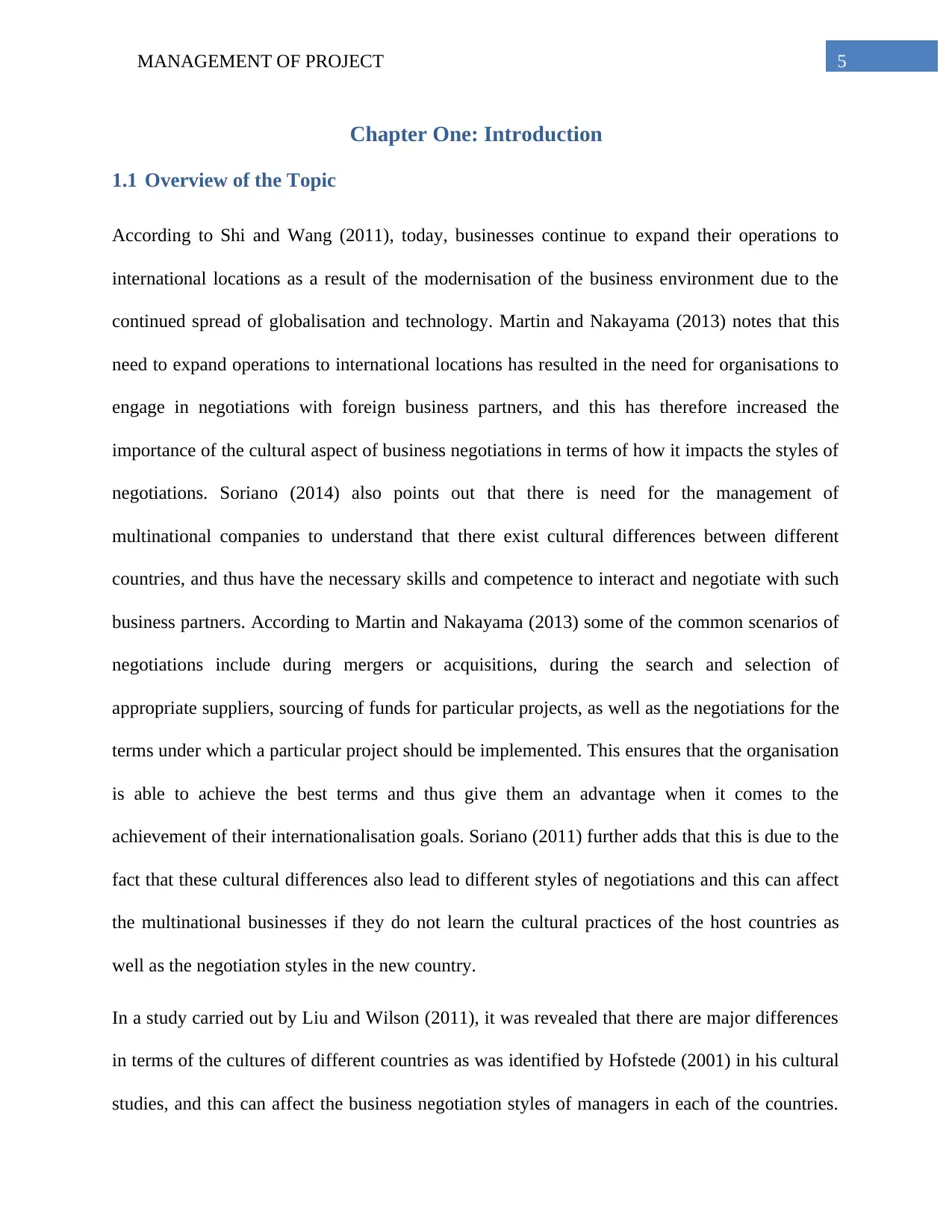
5MANAGEMENT OF PROJECT
Chapter One: Introduction
1.1 Overview of the Topic
According to Shi and Wang (2011), today, businesses continue to expand their operations to
international locations as a result of the modernisation of the business environment due to the
continued spread of globalisation and technology. Martin and Nakayama (2013) notes that this
need to expand operations to international locations has resulted in the need for organisations to
engage in negotiations with foreign business partners, and this has therefore increased the
importance of the cultural aspect of business negotiations in terms of how it impacts the styles of
negotiations. Soriano (2014) also points out that there is need for the management of
multinational companies to understand that there exist cultural differences between different
countries, and thus have the necessary skills and competence to interact and negotiate with such
business partners. According to Martin and Nakayama (2013) some of the common scenarios of
negotiations include during mergers or acquisitions, during the search and selection of
appropriate suppliers, sourcing of funds for particular projects, as well as the negotiations for the
terms under which a particular project should be implemented. This ensures that the organisation
is able to achieve the best terms and thus give them an advantage when it comes to the
achievement of their internationalisation goals. Soriano (2011) further adds that this is due to the
fact that these cultural differences also lead to different styles of negotiations and this can affect
the multinational businesses if they do not learn the cultural practices of the host countries as
well as the negotiation styles in the new country.
In a study carried out by Liu and Wilson (2011), it was revealed that there are major differences
in terms of the cultures of different countries as was identified by Hofstede (2001) in his cultural
studies, and this can affect the business negotiation styles of managers in each of the countries.
Chapter One: Introduction
1.1 Overview of the Topic
According to Shi and Wang (2011), today, businesses continue to expand their operations to
international locations as a result of the modernisation of the business environment due to the
continued spread of globalisation and technology. Martin and Nakayama (2013) notes that this
need to expand operations to international locations has resulted in the need for organisations to
engage in negotiations with foreign business partners, and this has therefore increased the
importance of the cultural aspect of business negotiations in terms of how it impacts the styles of
negotiations. Soriano (2014) also points out that there is need for the management of
multinational companies to understand that there exist cultural differences between different
countries, and thus have the necessary skills and competence to interact and negotiate with such
business partners. According to Martin and Nakayama (2013) some of the common scenarios of
negotiations include during mergers or acquisitions, during the search and selection of
appropriate suppliers, sourcing of funds for particular projects, as well as the negotiations for the
terms under which a particular project should be implemented. This ensures that the organisation
is able to achieve the best terms and thus give them an advantage when it comes to the
achievement of their internationalisation goals. Soriano (2011) further adds that this is due to the
fact that these cultural differences also lead to different styles of negotiations and this can affect
the multinational businesses if they do not learn the cultural practices of the host countries as
well as the negotiation styles in the new country.
In a study carried out by Liu and Wilson (2011), it was revealed that there are major differences
in terms of the cultures of different countries as was identified by Hofstede (2001) in his cultural
studies, and this can affect the business negotiation styles of managers in each of the countries.
⊘ This is a preview!⊘
Do you want full access?
Subscribe today to unlock all pages.

Trusted by 1+ million students worldwide
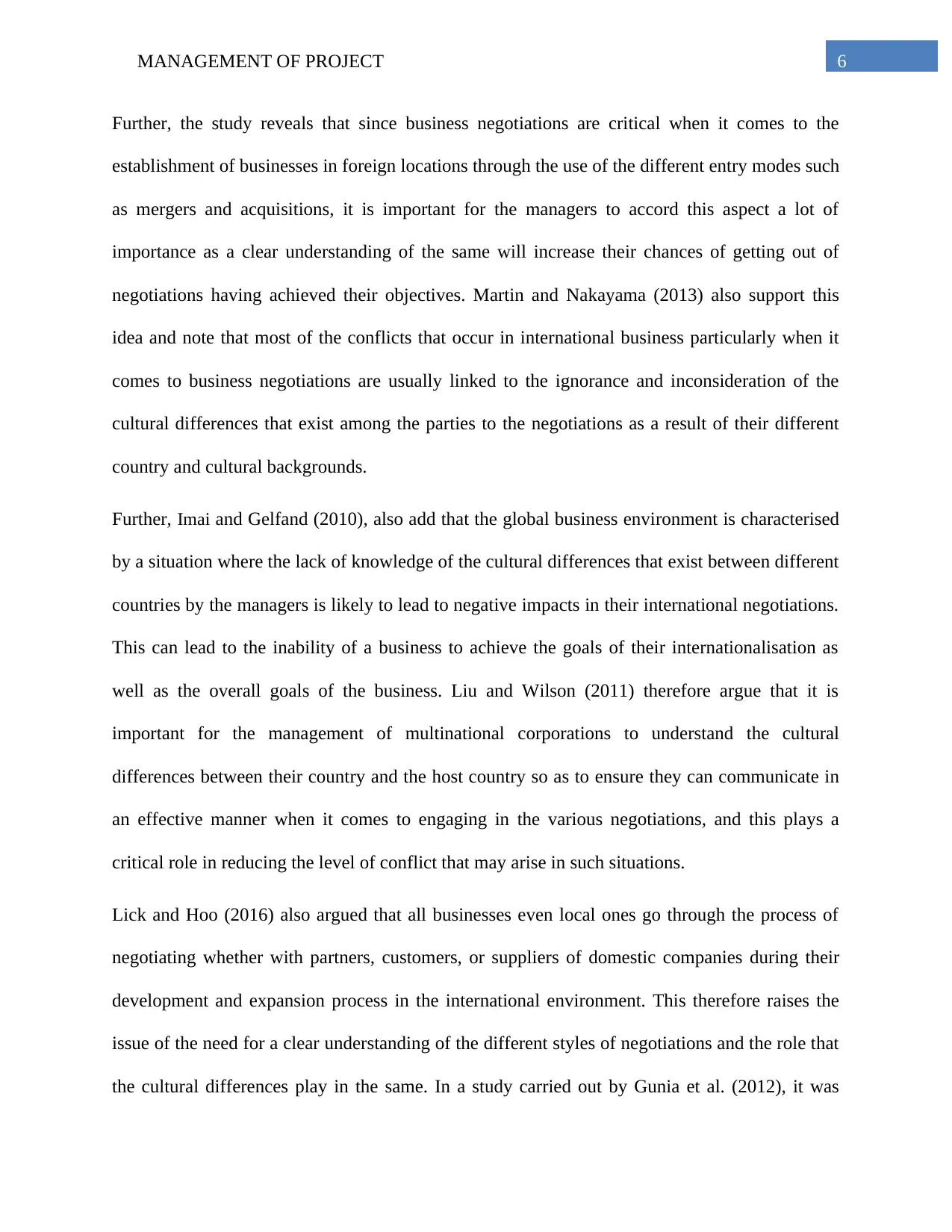
6MANAGEMENT OF PROJECT
Further, the study reveals that since business negotiations are critical when it comes to the
establishment of businesses in foreign locations through the use of the different entry modes such
as mergers and acquisitions, it is important for the managers to accord this aspect a lot of
importance as a clear understanding of the same will increase their chances of getting out of
negotiations having achieved their objectives. Martin and Nakayama (2013) also support this
idea and note that most of the conflicts that occur in international business particularly when it
comes to business negotiations are usually linked to the ignorance and inconsideration of the
cultural differences that exist among the parties to the negotiations as a result of their different
country and cultural backgrounds.
Further, Imai and Gelfand (2010), also add that the global business environment is characterised
by a situation where the lack of knowledge of the cultural differences that exist between different
countries by the managers is likely to lead to negative impacts in their international negotiations.
This can lead to the inability of a business to achieve the goals of their internationalisation as
well as the overall goals of the business. Liu and Wilson (2011) therefore argue that it is
important for the management of multinational corporations to understand the cultural
differences between their country and the host country so as to ensure they can communicate in
an effective manner when it comes to engaging in the various negotiations, and this plays a
critical role in reducing the level of conflict that may arise in such situations.
Lick and Hoo (2016) also argued that all businesses even local ones go through the process of
negotiating whether with partners, customers, or suppliers of domestic companies during their
development and expansion process in the international environment. This therefore raises the
issue of the need for a clear understanding of the different styles of negotiations and the role that
the cultural differences play in the same. In a study carried out by Gunia et al. (2012), it was
Further, the study reveals that since business negotiations are critical when it comes to the
establishment of businesses in foreign locations through the use of the different entry modes such
as mergers and acquisitions, it is important for the managers to accord this aspect a lot of
importance as a clear understanding of the same will increase their chances of getting out of
negotiations having achieved their objectives. Martin and Nakayama (2013) also support this
idea and note that most of the conflicts that occur in international business particularly when it
comes to business negotiations are usually linked to the ignorance and inconsideration of the
cultural differences that exist among the parties to the negotiations as a result of their different
country and cultural backgrounds.
Further, Imai and Gelfand (2010), also add that the global business environment is characterised
by a situation where the lack of knowledge of the cultural differences that exist between different
countries by the managers is likely to lead to negative impacts in their international negotiations.
This can lead to the inability of a business to achieve the goals of their internationalisation as
well as the overall goals of the business. Liu and Wilson (2011) therefore argue that it is
important for the management of multinational corporations to understand the cultural
differences between their country and the host country so as to ensure they can communicate in
an effective manner when it comes to engaging in the various negotiations, and this plays a
critical role in reducing the level of conflict that may arise in such situations.
Lick and Hoo (2016) also argued that all businesses even local ones go through the process of
negotiating whether with partners, customers, or suppliers of domestic companies during their
development and expansion process in the international environment. This therefore raises the
issue of the need for a clear understanding of the different styles of negotiations and the role that
the cultural differences play in the same. In a study carried out by Gunia et al. (2012), it was
Paraphrase This Document
Need a fresh take? Get an instant paraphrase of this document with our AI Paraphraser
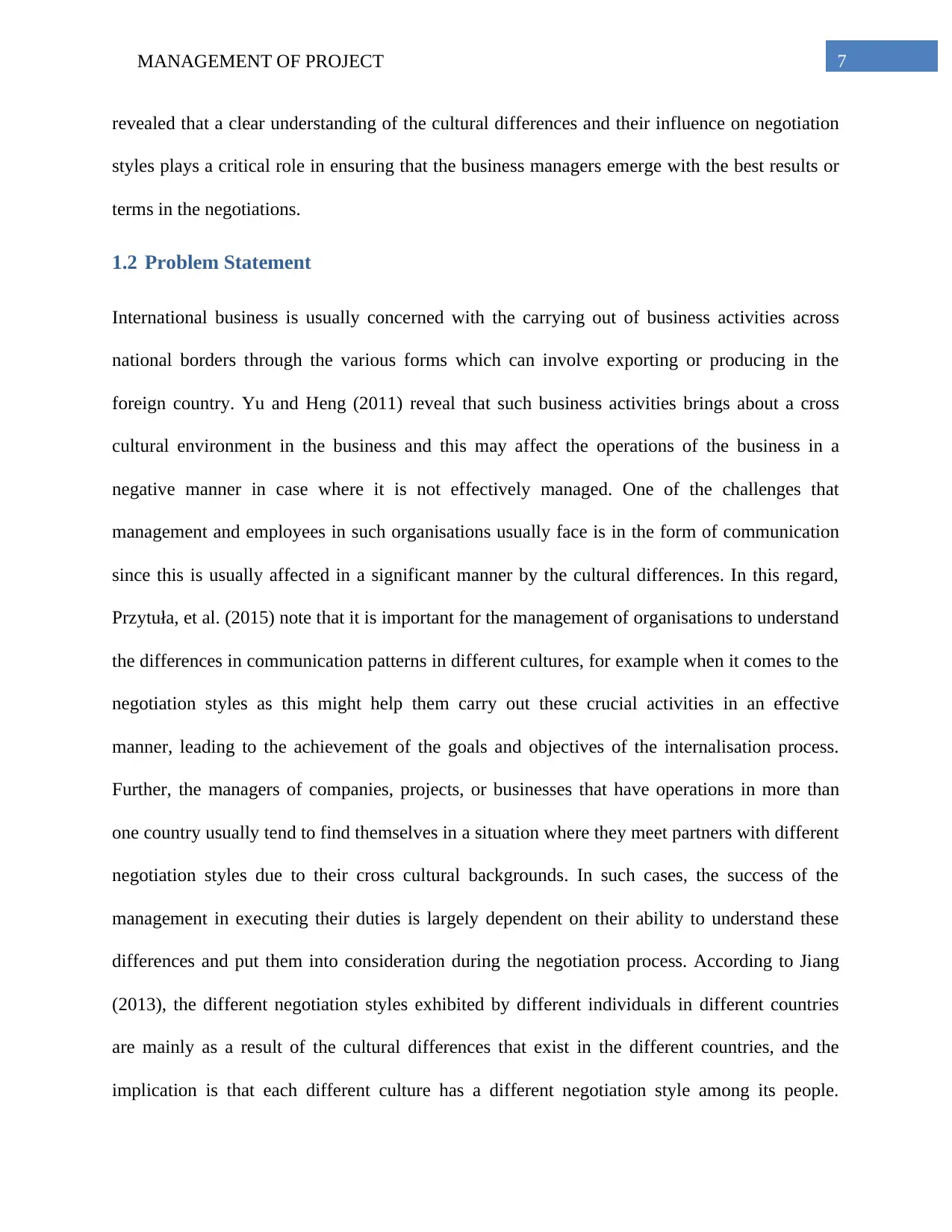
7MANAGEMENT OF PROJECT
revealed that a clear understanding of the cultural differences and their influence on negotiation
styles plays a critical role in ensuring that the business managers emerge with the best results or
terms in the negotiations.
1.2 Problem Statement
International business is usually concerned with the carrying out of business activities across
national borders through the various forms which can involve exporting or producing in the
foreign country. Yu and Heng (2011) reveal that such business activities brings about a cross
cultural environment in the business and this may affect the operations of the business in a
negative manner in case where it is not effectively managed. One of the challenges that
management and employees in such organisations usually face is in the form of communication
since this is usually affected in a significant manner by the cultural differences. In this regard,
Przytuła, et al. (2015) note that it is important for the management of organisations to understand
the differences in communication patterns in different cultures, for example when it comes to the
negotiation styles as this might help them carry out these crucial activities in an effective
manner, leading to the achievement of the goals and objectives of the internalisation process.
Further, the managers of companies, projects, or businesses that have operations in more than
one country usually tend to find themselves in a situation where they meet partners with different
negotiation styles due to their cross cultural backgrounds. In such cases, the success of the
management in executing their duties is largely dependent on their ability to understand these
differences and put them into consideration during the negotiation process. According to Jiang
(2013), the different negotiation styles exhibited by different individuals in different countries
are mainly as a result of the cultural differences that exist in the different countries, and the
implication is that each different culture has a different negotiation style among its people.
revealed that a clear understanding of the cultural differences and their influence on negotiation
styles plays a critical role in ensuring that the business managers emerge with the best results or
terms in the negotiations.
1.2 Problem Statement
International business is usually concerned with the carrying out of business activities across
national borders through the various forms which can involve exporting or producing in the
foreign country. Yu and Heng (2011) reveal that such business activities brings about a cross
cultural environment in the business and this may affect the operations of the business in a
negative manner in case where it is not effectively managed. One of the challenges that
management and employees in such organisations usually face is in the form of communication
since this is usually affected in a significant manner by the cultural differences. In this regard,
Przytuła, et al. (2015) note that it is important for the management of organisations to understand
the differences in communication patterns in different cultures, for example when it comes to the
negotiation styles as this might help them carry out these crucial activities in an effective
manner, leading to the achievement of the goals and objectives of the internalisation process.
Further, the managers of companies, projects, or businesses that have operations in more than
one country usually tend to find themselves in a situation where they meet partners with different
negotiation styles due to their cross cultural backgrounds. In such cases, the success of the
management in executing their duties is largely dependent on their ability to understand these
differences and put them into consideration during the negotiation process. According to Jiang
(2013), the different negotiation styles exhibited by different individuals in different countries
are mainly as a result of the cultural differences that exist in the different countries, and the
implication is that each different culture has a different negotiation style among its people.
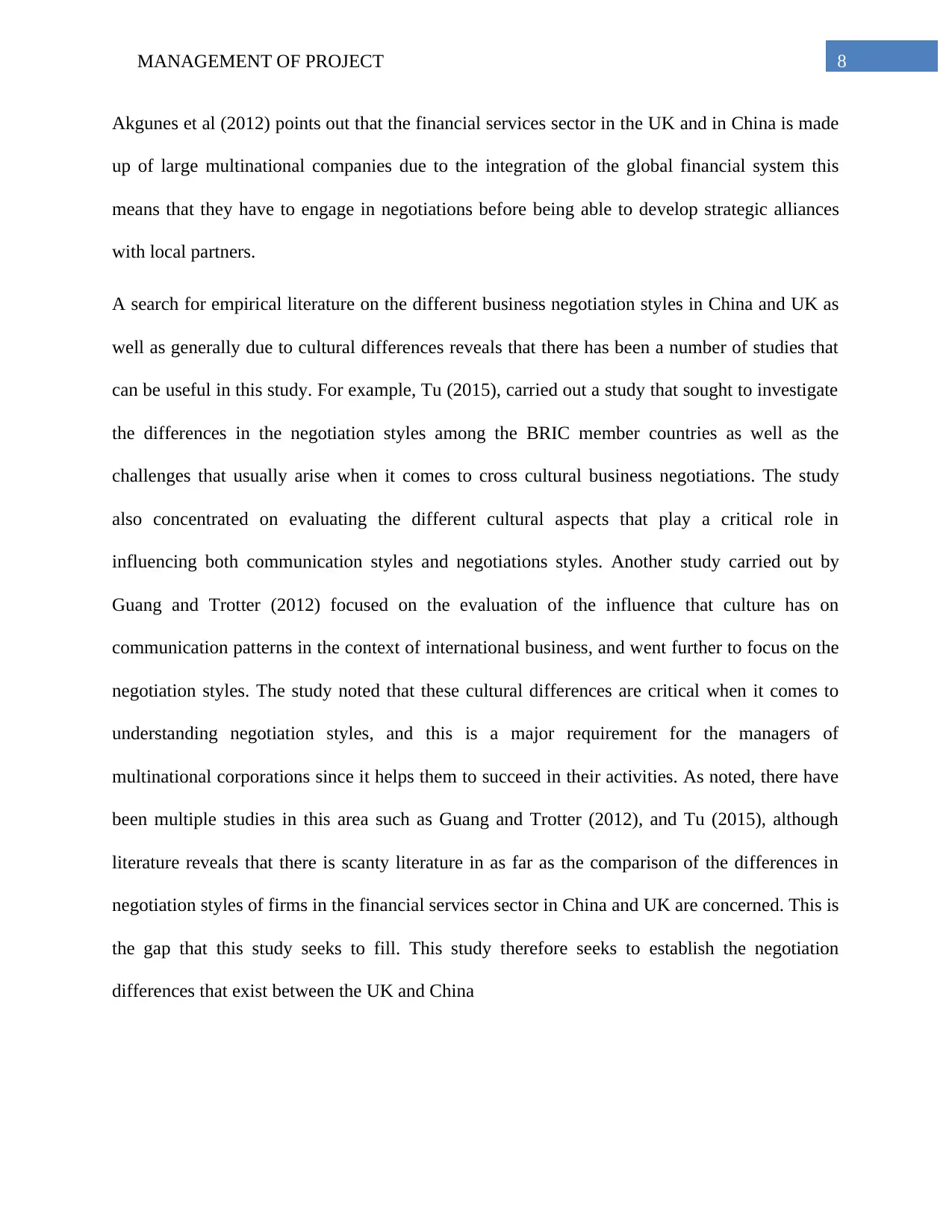
8MANAGEMENT OF PROJECT
Akgunes et al (2012) points out that the financial services sector in the UK and in China is made
up of large multinational companies due to the integration of the global financial system this
means that they have to engage in negotiations before being able to develop strategic alliances
with local partners.
A search for empirical literature on the different business negotiation styles in China and UK as
well as generally due to cultural differences reveals that there has been a number of studies that
can be useful in this study. For example, Tu (2015), carried out a study that sought to investigate
the differences in the negotiation styles among the BRIC member countries as well as the
challenges that usually arise when it comes to cross cultural business negotiations. The study
also concentrated on evaluating the different cultural aspects that play a critical role in
influencing both communication styles and negotiations styles. Another study carried out by
Guang and Trotter (2012) focused on the evaluation of the influence that culture has on
communication patterns in the context of international business, and went further to focus on the
negotiation styles. The study noted that these cultural differences are critical when it comes to
understanding negotiation styles, and this is a major requirement for the managers of
multinational corporations since it helps them to succeed in their activities. As noted, there have
been multiple studies in this area such as Guang and Trotter (2012), and Tu (2015), although
literature reveals that there is scanty literature in as far as the comparison of the differences in
negotiation styles of firms in the financial services sector in China and UK are concerned. This is
the gap that this study seeks to fill. This study therefore seeks to establish the negotiation
differences that exist between the UK and China
Akgunes et al (2012) points out that the financial services sector in the UK and in China is made
up of large multinational companies due to the integration of the global financial system this
means that they have to engage in negotiations before being able to develop strategic alliances
with local partners.
A search for empirical literature on the different business negotiation styles in China and UK as
well as generally due to cultural differences reveals that there has been a number of studies that
can be useful in this study. For example, Tu (2015), carried out a study that sought to investigate
the differences in the negotiation styles among the BRIC member countries as well as the
challenges that usually arise when it comes to cross cultural business negotiations. The study
also concentrated on evaluating the different cultural aspects that play a critical role in
influencing both communication styles and negotiations styles. Another study carried out by
Guang and Trotter (2012) focused on the evaluation of the influence that culture has on
communication patterns in the context of international business, and went further to focus on the
negotiation styles. The study noted that these cultural differences are critical when it comes to
understanding negotiation styles, and this is a major requirement for the managers of
multinational corporations since it helps them to succeed in their activities. As noted, there have
been multiple studies in this area such as Guang and Trotter (2012), and Tu (2015), although
literature reveals that there is scanty literature in as far as the comparison of the differences in
negotiation styles of firms in the financial services sector in China and UK are concerned. This is
the gap that this study seeks to fill. This study therefore seeks to establish the negotiation
differences that exist between the UK and China
⊘ This is a preview!⊘
Do you want full access?
Subscribe today to unlock all pages.

Trusted by 1+ million students worldwide
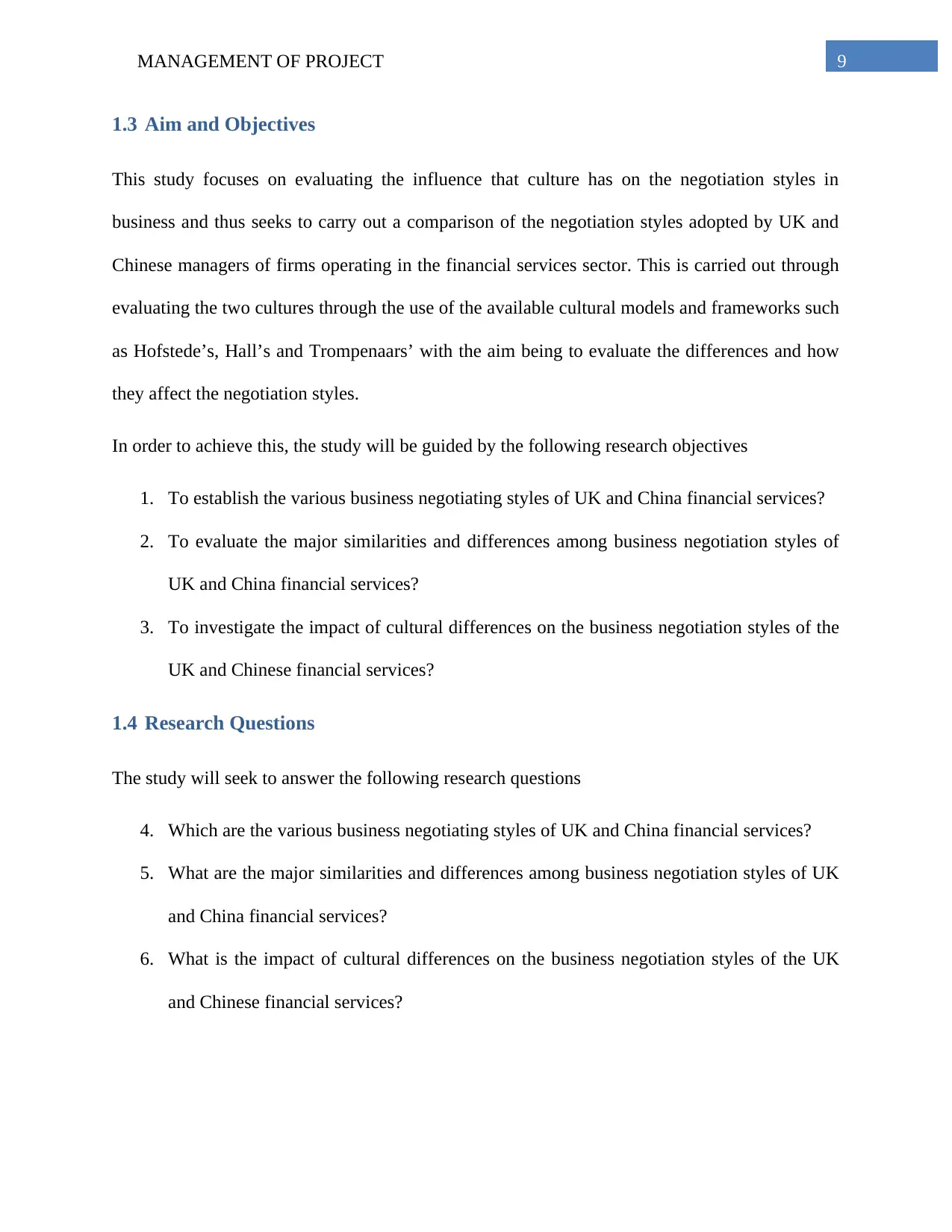
9MANAGEMENT OF PROJECT
1.3 Aim and Objectives
This study focuses on evaluating the influence that culture has on the negotiation styles in
business and thus seeks to carry out a comparison of the negotiation styles adopted by UK and
Chinese managers of firms operating in the financial services sector. This is carried out through
evaluating the two cultures through the use of the available cultural models and frameworks such
as Hofstede’s, Hall’s and Trompenaars’ with the aim being to evaluate the differences and how
they affect the negotiation styles.
In order to achieve this, the study will be guided by the following research objectives
1. To establish the various business negotiating styles of UK and China financial services?
2. To evaluate the major similarities and differences among business negotiation styles of
UK and China financial services?
3. To investigate the impact of cultural differences on the business negotiation styles of the
UK and Chinese financial services?
1.4 Research Questions
The study will seek to answer the following research questions
4. Which are the various business negotiating styles of UK and China financial services?
5. What are the major similarities and differences among business negotiation styles of UK
and China financial services?
6. What is the impact of cultural differences on the business negotiation styles of the UK
and Chinese financial services?
1.3 Aim and Objectives
This study focuses on evaluating the influence that culture has on the negotiation styles in
business and thus seeks to carry out a comparison of the negotiation styles adopted by UK and
Chinese managers of firms operating in the financial services sector. This is carried out through
evaluating the two cultures through the use of the available cultural models and frameworks such
as Hofstede’s, Hall’s and Trompenaars’ with the aim being to evaluate the differences and how
they affect the negotiation styles.
In order to achieve this, the study will be guided by the following research objectives
1. To establish the various business negotiating styles of UK and China financial services?
2. To evaluate the major similarities and differences among business negotiation styles of
UK and China financial services?
3. To investigate the impact of cultural differences on the business negotiation styles of the
UK and Chinese financial services?
1.4 Research Questions
The study will seek to answer the following research questions
4. Which are the various business negotiating styles of UK and China financial services?
5. What are the major similarities and differences among business negotiation styles of UK
and China financial services?
6. What is the impact of cultural differences on the business negotiation styles of the UK
and Chinese financial services?
Paraphrase This Document
Need a fresh take? Get an instant paraphrase of this document with our AI Paraphraser
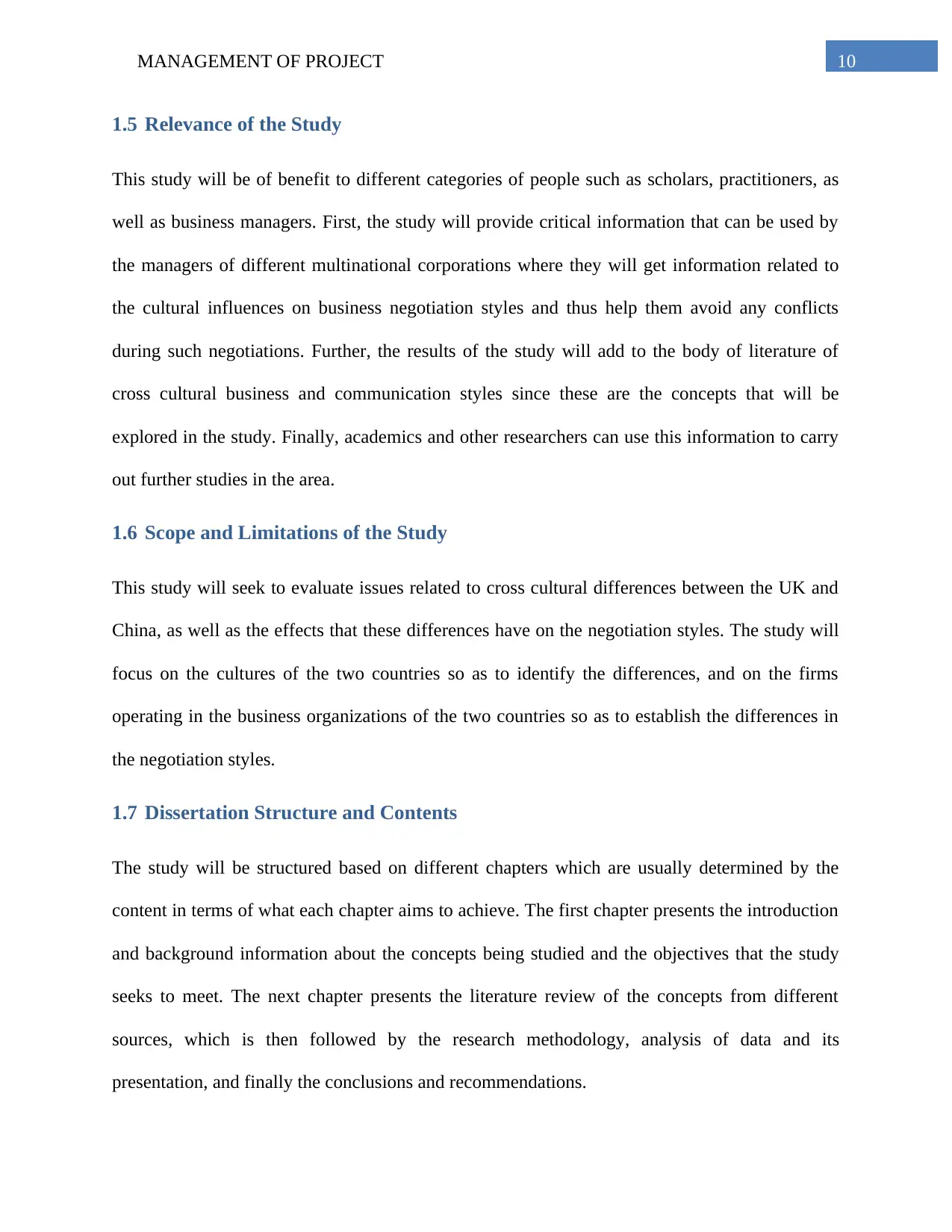
10MANAGEMENT OF PROJECT
1.5 Relevance of the Study
This study will be of benefit to different categories of people such as scholars, practitioners, as
well as business managers. First, the study will provide critical information that can be used by
the managers of different multinational corporations where they will get information related to
the cultural influences on business negotiation styles and thus help them avoid any conflicts
during such negotiations. Further, the results of the study will add to the body of literature of
cross cultural business and communication styles since these are the concepts that will be
explored in the study. Finally, academics and other researchers can use this information to carry
out further studies in the area.
1.6 Scope and Limitations of the Study
This study will seek to evaluate issues related to cross cultural differences between the UK and
China, as well as the effects that these differences have on the negotiation styles. The study will
focus on the cultures of the two countries so as to identify the differences, and on the firms
operating in the business organizations of the two countries so as to establish the differences in
the negotiation styles.
1.7 Dissertation Structure and Contents
The study will be structured based on different chapters which are usually determined by the
content in terms of what each chapter aims to achieve. The first chapter presents the introduction
and background information about the concepts being studied and the objectives that the study
seeks to meet. The next chapter presents the literature review of the concepts from different
sources, which is then followed by the research methodology, analysis of data and its
presentation, and finally the conclusions and recommendations.
1.5 Relevance of the Study
This study will be of benefit to different categories of people such as scholars, practitioners, as
well as business managers. First, the study will provide critical information that can be used by
the managers of different multinational corporations where they will get information related to
the cultural influences on business negotiation styles and thus help them avoid any conflicts
during such negotiations. Further, the results of the study will add to the body of literature of
cross cultural business and communication styles since these are the concepts that will be
explored in the study. Finally, academics and other researchers can use this information to carry
out further studies in the area.
1.6 Scope and Limitations of the Study
This study will seek to evaluate issues related to cross cultural differences between the UK and
China, as well as the effects that these differences have on the negotiation styles. The study will
focus on the cultures of the two countries so as to identify the differences, and on the firms
operating in the business organizations of the two countries so as to establish the differences in
the negotiation styles.
1.7 Dissertation Structure and Contents
The study will be structured based on different chapters which are usually determined by the
content in terms of what each chapter aims to achieve. The first chapter presents the introduction
and background information about the concepts being studied and the objectives that the study
seeks to meet. The next chapter presents the literature review of the concepts from different
sources, which is then followed by the research methodology, analysis of data and its
presentation, and finally the conclusions and recommendations.
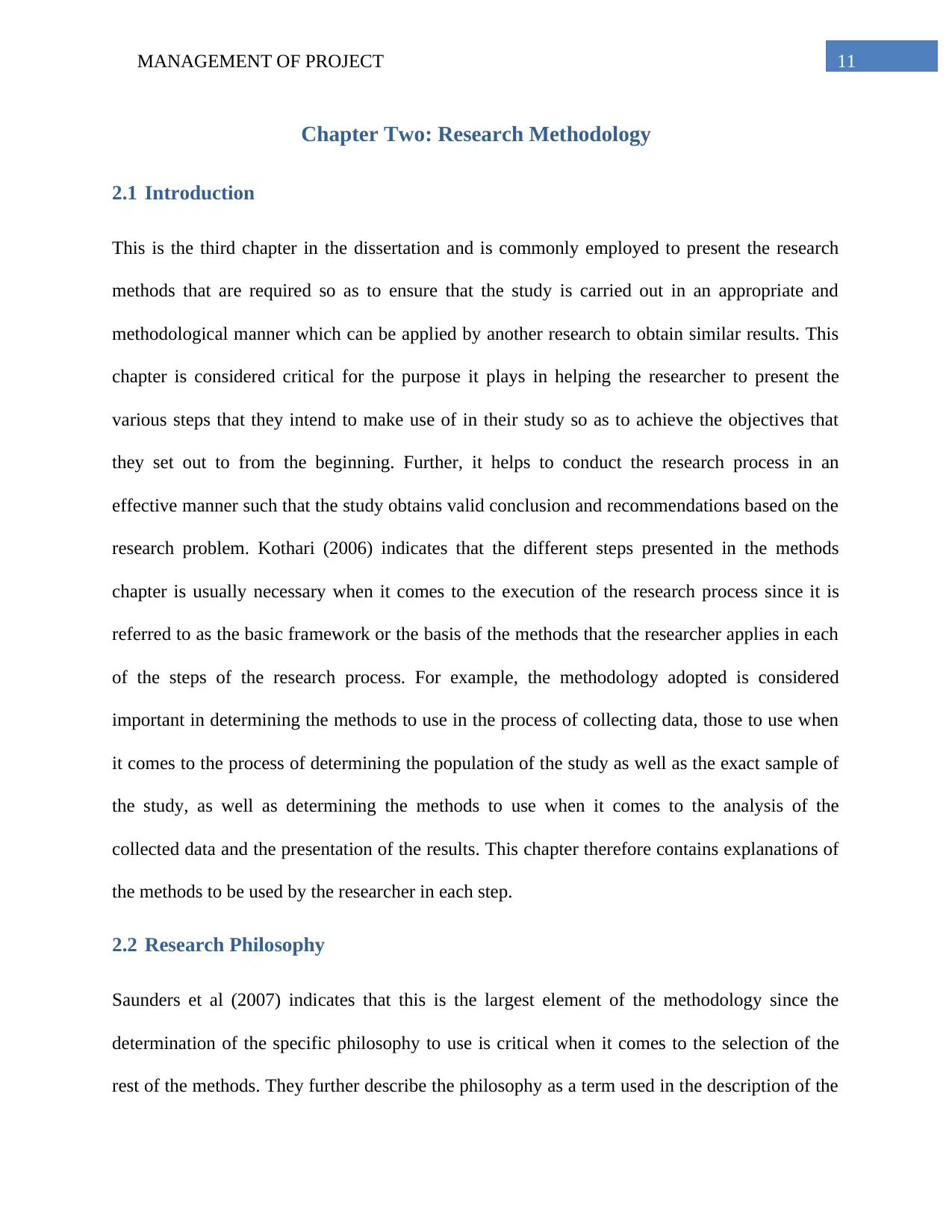
11MANAGEMENT OF PROJECT
Chapter Two: Research Methodology
2.1 Introduction
This is the third chapter in the dissertation and is commonly employed to present the research
methods that are required so as to ensure that the study is carried out in an appropriate and
methodological manner which can be applied by another research to obtain similar results. This
chapter is considered critical for the purpose it plays in helping the researcher to present the
various steps that they intend to make use of in their study so as to achieve the objectives that
they set out to from the beginning. Further, it helps to conduct the research process in an
effective manner such that the study obtains valid conclusion and recommendations based on the
research problem. Kothari (2006) indicates that the different steps presented in the methods
chapter is usually necessary when it comes to the execution of the research process since it is
referred to as the basic framework or the basis of the methods that the researcher applies in each
of the steps of the research process. For example, the methodology adopted is considered
important in determining the methods to use in the process of collecting data, those to use when
it comes to the process of determining the population of the study as well as the exact sample of
the study, as well as determining the methods to use when it comes to the analysis of the
collected data and the presentation of the results. This chapter therefore contains explanations of
the methods to be used by the researcher in each step.
2.2 Research Philosophy
Saunders et al (2007) indicates that this is the largest element of the methodology since the
determination of the specific philosophy to use is critical when it comes to the selection of the
rest of the methods. They further describe the philosophy as a term used in the description of the
Chapter Two: Research Methodology
2.1 Introduction
This is the third chapter in the dissertation and is commonly employed to present the research
methods that are required so as to ensure that the study is carried out in an appropriate and
methodological manner which can be applied by another research to obtain similar results. This
chapter is considered critical for the purpose it plays in helping the researcher to present the
various steps that they intend to make use of in their study so as to achieve the objectives that
they set out to from the beginning. Further, it helps to conduct the research process in an
effective manner such that the study obtains valid conclusion and recommendations based on the
research problem. Kothari (2006) indicates that the different steps presented in the methods
chapter is usually necessary when it comes to the execution of the research process since it is
referred to as the basic framework or the basis of the methods that the researcher applies in each
of the steps of the research process. For example, the methodology adopted is considered
important in determining the methods to use in the process of collecting data, those to use when
it comes to the process of determining the population of the study as well as the exact sample of
the study, as well as determining the methods to use when it comes to the analysis of the
collected data and the presentation of the results. This chapter therefore contains explanations of
the methods to be used by the researcher in each step.
2.2 Research Philosophy
Saunders et al (2007) indicates that this is the largest element of the methodology since the
determination of the specific philosophy to use is critical when it comes to the selection of the
rest of the methods. They further describe the philosophy as a term used in the description of the
⊘ This is a preview!⊘
Do you want full access?
Subscribe today to unlock all pages.

Trusted by 1+ million students worldwide
1 out of 69
Related Documents
Your All-in-One AI-Powered Toolkit for Academic Success.
+13062052269
info@desklib.com
Available 24*7 on WhatsApp / Email
![[object Object]](/_next/static/media/star-bottom.7253800d.svg)
Unlock your academic potential
Copyright © 2020–2025 A2Z Services. All Rights Reserved. Developed and managed by ZUCOL.





